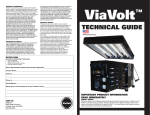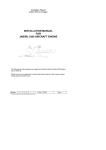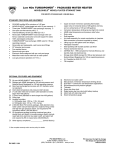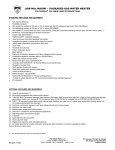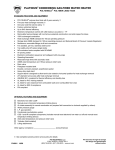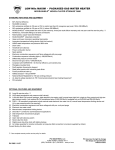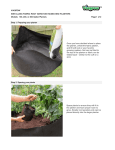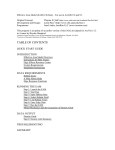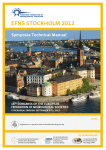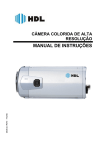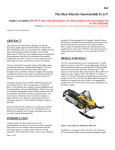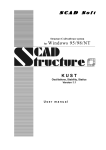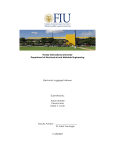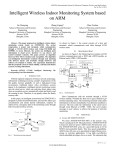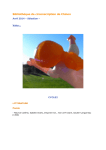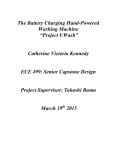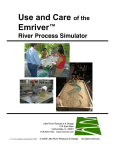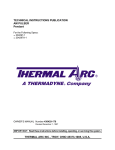Download File - Northern Arizona University
Transcript
Solar Autoclave for Rural Areas By: Blake Lawrence, Eric Brettner, Yuchen Liu, Kyle Godwin, and Adam Compton Team 6 Final Report Document Submitted towards partial fulfillment of the requirements for Mechanical Engineering Design – Spring 2013 Department of Mechanical Engineering Northern Arizona University Flagstaff, AZ 86011 Table of Contents Abstract............................................................................................................................................3 Problem Statement.......................................................................................................................4 Objectives ....................................................................................................................................4 Constraints ...................................................................................................................................5 Thermal Capture ..........................................................................................................................6 Insulation .....................................................................................................................................7 Methods ...........................................................................................................................................8 Thermal Circuit..........................................................................................................................11 Final Design...................................................................................................................................13 Manufacturing ...............................................................................................................................14 Boiler .........................................................................................................................................14 Parabolic Trough .......................................................................................................................17 Pressure Vessel ..........................................................................................................................19 Homemade Pressure Vessel.......................................................................................................22 Cost Analysis.................................................................................................................................24 User Interface ................................................................................................................................25 Conclusion .....................................................................................................................................26 References .....................................................................................................................................28 Appendices ....................................................................................................................................29 Appendix A................................................................................................................................30 Appendix B................................................................................................................................34 Abstract An autoclave is a device used to sterilize medical equipment. While there are many sterilization techniques available, the preferred method for this project is steam sterilization. In this process, water is pressurized to raise its boiling point. When this occurs, steam will be created at a temperature higher than 100oC. In fact, in order to fully eliminate all prions and bacteria associated with disease, saturated steam needs to be at least 121oC when in contact with the equipment being sterilized. Currently, many advanced designs are being used in western countries. These designs are usually powered with electricity and use computers to monitor the internal temperatures and pressures. Unfortunately, many developing areas around the world do not have the technology available to operate these types of autoclaves. As a result, nurses and doctors at remote health clinics in these rural areas are continually challenged with the decision to operate with unsanitary equipment, risking the spread of infection, or to not operate at all. A solar autoclave provides an alternative solution to this problem. Using only solar radiation, a solar autoclave can provide remote health clinics with an inexpensive, efficient way to sterilize medical equipment. Our design was fabricated to be strong, reliable, and cost efficient. The solar autoclave testing was generally successful reaching just shy of our goal temperature. This was caused by heat loss. The final numbers during testing were 1.2 bar (gauge) and a temperature of 118oC. Solar Autoclave for Rural Areas Page 3 Figure 1 – Solar Autoclave for Rural Areas Introduction Problem Statement Many developing areas around the world have limited availability to sterilized medical equipment. Currently, several countries in rural areas cannot properly sterilize what limited medical equipment is available. This results in medical treatment or surgery with unsafe equipment, risking the chance of infection and possibly the life of the patient. Sometimes, no treatment is done at all. This need is located across the globe, but for this project the location of focus will be Central Africa. This region was chosen based off of the lack of resources and abundant sunlight. • • Overall Goal Statement – To create a solar autoclave that can be easily used at remote clinics in rural areas. Overall Scope of Goal – The project will be aimed for several regions across the globe in need of sterile medical equipment, with ample amounts of sunlight to power the solar autoclave. Objectives The three main objectives for this project include: • • To provide remote clinics in rural areas with the means to sterilize medical equipment. To create a flexible design from location to location. Solar Autoclave for Rural Areas Page 4 • o A solar autoclave can be implemented in any region with enough sunlight available. This design will be able to me modified using the resources and materials locally available. The individual parts can be repaired or replaced from local, readily available materials. Below is a table of the objectives listed along with the basis for measurement for each. Table 1 – Table of Objectives Constraints There are not many constraints for this project. The most important one is to sterilize the medical equipment. This constraint can be broken up into two categories: temperature and pressure. These two sub constraints include: • • Temperature of steam must reach and hold 121oC for at least 15 minutes. Pressure must reach and hold 2.05 bar (absolute pressure) for at least 15 minutes. Research Different types of sterilization were considered. After learning about dry heat and steam sterilization, the choice was clear. Both methods offer advantages and disadvantages, but steam sterilization was determined to be the dominant method. The pros and cons for dry sterilization are listed below: Pros: • • Does not require water Produces a lower gauge pressure, meaning the process is safer Cons: • Takes 2 hours at 160°C to clean equipment Solar Autoclave for Rural Areas Page 5 • Does not fully sterilize medical equipment o Does not kill all prions and proteins associated with bacteria Although dry heat sterilization is safer to operate, it takes much longer than steam sterilization and does not fully sterilize the medical equipment. Further research showed that saturated steam sterilization requires a temperature of 121°C for only 15 minutes and fully sterilizes the medical equipment; steam sterilization is the better method because the contact for heat transfer is more efficient. Different types of medical equipment that are in need of sterilization at these remote clinics range from syringes to scalpels. A majority of the equipment are small handheld devices. This medical equipment is used by doctors and nurses at these remote clinics. So operation of the solar autoclave will need to be operated by doctors and nurses, but optimally by anyone. Concept Research The initial phase of the solar autoclave project included researching ideas for each of the major component of our design. The main components include: • • Thermal Capture Insulation Thermal Capture For solar thermal capture, there are three main designs that are used for efficiently harnessing the power of the sun. A parabolic trough, dish, and Fresnel lens all focus the radiation of the sun to a single focal point. Focal points are different depending on the size and shape of the mirror or lens. Having a mirror or lens with a larger area than the pressure vessel and focusing the energy to a smaller point allows the system to reach and maintain the required temperature to superheat the steam at 121˚C. Parabolic troughs, shown in Figure 2, focus heat onto a long cylinder of fluid which lies parallel to the trough at the focal point. These require a large area to operate. Parabolic dishes, shown in Figure 3, use a circular mirror to focus the heat onto a container held at the focal point. These are effective if used correctly and also require a large area. Both parabolic dishes and troughs can be made from a mosaic of smaller mirrors, allowing them to be made cheaper than a single mirror. Finally, a Fresnel lens uses concentric rings over a plastic lens. These rings are all manufactured to focus light to one location: the focal point. Since the amount of heat and radiation is intensified at this point, the rate of heat transfer is dramatically higher. This process takes a larger surface area of thermal collection than our pressure vessel, and focuses the heat onto that vessel, heating the system. Fresnel lenses, shown in Figure 4 can be found in rear projection televisions. Usually made from plastic, these lenses are lighter, cheaper, and more durable than mirrors. A downfall of lenses is that they act as a filter and can absorb some of the energy. For this application, this may or may not be a factor. A major problem with Fresnel Solar Autoclave for Rural Areas Page 6 lenses is their availability in remote countries. Locating one of these lenses or the flat panel televisions they are removed from may be difficult, if not impossible. For the solar autoclave a parabolic trough is easier to manufacture and the clear choice for the final design. Figure 2 – Parabolic Trough Figure 3 – Parabolic Dish Figure 4 – Fresnel Lens Insulation Reaching 121 ˚C is the goal for obtaining sterility, but this temperature must be maintained for a certain time span in order to guarantee every piece of equipment is clean and safe to use. Using insulation can help to retain heat and minimize heat loss. The thin walls of the pressure vessel and the hose are two crucial places where heat will try to escape. The boiler will be covered with transparent plastic to help stop forced convection. The table below lists a variety of materials with low thermal conductivity. Materials with a low thermal conductivity will maximize the thermal resistance preventing heat loss. Solar Autoclave for Rural Areas Page 7 Table 2 – Thermal Conductivity [k] of Insulation Materials Thermablok Aerogel is clearly the best choice, but unfortunately Thermablok Aerogel is very expensive and hard to obtain. It was developed by NASA and is currently the most efficient insulation material on the market. Unfortunately, it would be almost impossible to obtain in a developing or rural area. The next best material for insulation was chosen as Styrofoam for the hose and fiberglass for the pressure vessel, which has both a lower thermal conductivity than other materials and is readily available. Both Styrofoam and fiberglass were considered to be readily available because of its common use. Methods = ∙( 2− 1) (1) Where: E = Energy, in kJ m = Mass of water, in kg u = Internal energy, in For the solar autoclave to properly sterilize the medical equipment, the temperature of the steam will need to be brought from room temperature (20 C) to 121 C. After using Shapiro’s Fundamentals of Engineering Thermodynamics [1], the internal energy values at room temperature and 121°C can be found as shown in the table below. Based on these values and Equation 1 above, the energy, or heat transfer value can then be determined once the mass of water is known. The boiler will use 2 liters of water to fill a larger pressure vessel with steam. At room temperature, 2 liters of water equates to 2 kilograms. Therefore, the mass of water in the system will be approximately 2 kilograms within the boiler. Solar Autoclave for Rural Areas Page 8 Table 3 – Thermodynamic Properties for Saturated Liquid Using Equation 1 above, the energy required to heat the water in the autoclave is found to be 847,604 Joules. Once the energy has been transferred to the water within the boiler the steam then slowly fills up the hose and pressure vessel to evacuate the air. Once fully filled with steam, the pressure vessel will be closed using the ball valve on the bottom of the vessel. At this point, the pressure will begin to rise and eventually overcome the pressure regulator system located on the pressure vessel. The pressure regulator system monitors and regulates pressure so the system will never go over the projected pressure. Thermal Capture Thermal capture is determined from the radiation being emitted from the sun. Applying the equations from above, the projected area needed to acquire the necessary power is found from Equation 2 below: = · · · (2) Where: = the incoming power of the sun, in W = the absorptivity of the bottom of the pressure vessel = the reflectivity of the material on parabolic trough = the solar irradiance, in 2 = the projected area from the trough, in 2 This equation can then be manipulated to solve for the projected area, shown in Equation 3 below: = · · · · (3) Where: E = the energy required to raise the water temperature, in J t = the time allotted to reach goal temperature, in seconds Solar Autoclave for Rural Areas Page 9 = the estimated efficiency of the trough Emissivity is a significant factor in how efficient the solar autoclave can be. Emissivity, , is equal to absorptivity, , and directly related to reflectivity, . Therefore, a lower emissivity value results in a higher reflectivity value. For the parabolic trough to effectively collect solar power, reflectivity is very important. Equation 4 below shows the correlation between the two: =1− (4) Where: = the emissivity constant Table 4 below shows the different emissivity and resulting reflectivity values of various materials being considered for the parabolic trough. Table 4 – Material Emissivity and Reflectivity The importance of reflectivity requires a reliable material which can be easily replaced. Mylar is affordable, abundant, and lightweight. The absorptivity of black spray paint was found to be 0.95, which was then lowered to 0.9 in order to be conservative in calculations. The solar irradiance constant is assumed to be 850 2, but may vary between regions. In addition, a half hour of time was estimated to heat the required amount of water, which equates to 1,800 seconds. A 60% efficiency for the homemade trough was also estimated. Finally, Equation 3 from above is used to solve for the projected area of the parabolic trough. = 847604 [ ]1800 .9.97(.6)(850 2)=1.06 2 Increasing the projected area will help to ensure the sterilization temperature is reached even if the efficiency of the home made trough is less than 60% since the reflective surface will not be perfect. This measurement is on a square meter basis, and can be used to solve for the required dimensions for the trough. The trough will have a length 2 meters and width of 0.75 meters. Solar Autoclave for Rural Areas Page 10 A parabolic trough functions by reflecting the solar irradiance to a point along the length of the trough, or focal point. To optimize the power reflected by a parabolic trough, the boiler must be placed at the proper location depending on shape and dimensions of the parabola. Using the known length and width needed to obtain goal temperature as well as an arbitrary focal length of 0.15 meters, the depth of the trough can be found. Figure 5 below shows the variables of the parabolic trough. Figure 5 – The variables of the solar collector Equation 5 can then be used to solve for the depth of the trough. = 224 (5) Where: d = the depth of the trough, in m D = the diameter, in m f = the focal length, in m Solving for the depth with the diameter and focal length stated above will be 0.234 meters. Equation 6 below will then solve for the shape of the parabola of the trough. = 24 (6) Thermal Circuit The thermal circuit in Figure 6 demonstrates the flow of heat through the system. Heat enters the system at the letter Q, which stands for heat flow, and travels to the right. The heat flow then comes to its first red circle, which stands for the temperature of the water inside of the boiler. The heat continues to travel to the right through either of the remaining resistors to the last red circle, the temperature of the atmosphere, the surrounding air around the autoclave. Solar Autoclave for Rural Areas Page 11 Figure 6 – Temperature vs. Thermocouple Number for Aluminum Solar Autoclave for Rural Areas Page 12 Final Design The final design harnesses the power of the sun using a trough, shaped from sheet metal, to collect the energy and focus that energy along a pipe or boiler. The reflectivity of the surface facing the boiler is extremely important. To improve this, the surface will be lined with Mylar. The boiler is exposed to the highest temperatures so corrosion is a large factor, especially when water is a main component of this system. For these reasons, schedule 40 galvanized steel was chosen for the material of the pipe because it is both strong and resists corrosion. A brass ball valve, located at the top of the inclined boiler, allows safe pouring of the water and removing of the excess water. Steam then passes through the hose to the secondary chamber containing the medical equipment. The steam, being less dense than the air within the chamber, slowly pushes the air out of the valve located at the bottom of the chamber. Evacuating the air creates a better environment to sanitize the equipment. The valve should be closed once it begins discharging steam. After the valve is closed, the pressure begins to rise and therefore the temperature. The pressure and temperature will continue to raise in the boiler, and in turn the pressure vessel. This process will continue for at least 15-30 minutes until the equipment is safe for medical purposes. Figure 7 – Solar Autoclave Prototype Design in SolidWorks As you can tell from Figure 7, the Solar Autoclave Prototype, nicknamed “Troughdor”, has several parts that involve its working process. The water is placed in the boiler pipe, directly at Solar Autoclave for Rural Areas Page 13 the focal point of the trough. The pipe is held in place by the ends of the trough, one at the bottom and one at the top. The capped end of the pipe slides into place via a pocket at the end of the trough design. Since this design is only a prototype, it was decided that a lowering and raising mechanism was not necessary in this design. Therefore, the trough is positioned by cinder blocks located at the bottom of the trough. However, mobility of the prototype is essential at this stage. The prototype carries a ‘wheelbarrow’ design with two wheels hanging on the end of the trough. Manufacturing Boiler The boiler spans a long distance to absorb the heat so the best choice to achieve this is a piping system. Piping also is safe, both for water corrosion and against the temperature and pressure. The smallest factor of safety on the boiler system is 4. The boiler will be made from various components. These are listed as follows from the bottom working the way to the top (picture follows description). Galvanized 1-1/4” NPT Female cap – this cap will seal the bottom end with a factor of safety of 20 and an upper temperature range of 176˚C. Figure 8 – Female Galvanized Cap Galvanized 1-1/2” X 10' NPT Male pipe – the pipe is the main body of the boiler that will be collecting the energy and transferring the energy to the water to create the steam needed. This component also has a factor of safety of 20 and an upper temperature range of 176˚C. Figure 9 – Galvanized Pipe Solar Autoclave for Rural Areas Page 14 Galvanized 1-1/2” X 1-1/2” X 3/4" Reducing Tee Fitting – with this fitting attached to the top of the pipe it will allow two points of entry. The perpendicular, or top fitting will allow water to be added to the system when beginning. The parallel fitting will allow the steam to travel down to the pressure vessel. This component also has a factor of safety of 20 and an upper temperature range of 176˚C. Figure 10 – Female Galvanized Tee Fitting Galvanized 1-1/2” Plug – this plug will allow the addition of water to the system with then safely sealing the perpendicular section of the tee fitting. This component also has a factor of safety of 20 and an upper temperature range of 176˚C. Figure 11 – Galvanized Plug Brass NPT Ball Valve (Male to Female) 3/4" – attached to the parallel end of the tee fitting this will allow (once the boiler is taken out of the sun) a shut off valve, so the sterilized medical equipment can be safely removed. This attachment has a factor of safety of 16 and upper temperature range of 185˚C. Figure 12 – Brass NPT Ball Valve Dixon Stainless Steel 316 3/4” NPT Male 3/4" Hose Barb – attached to the female end of the ball valve this will allow a safe connection to the hose that travels to the pressure vessel. Attached over the hose will be a hose clamp to ensure the hose does not come free during use. Solar Autoclave for Rural Areas Page 15 Figure 13 – Hose Barb Gates Durion Silicon Heater Hose inside Diameter 3/4” – the hose will travel from the boiler to the pressure vessel providing steam. The hose has a working pressure of 3.5 bar and an upper temperature range of 204˚C. Figure 14 – Gates Durion Silicon Heater Hose Instructions to build: The galvanized piping was cut and tapped on site at Home Depot to the desired length. Next step is to Teflon all threads to ensure water tight steal. Then attach the cap located at the bottom of the shaft, secure tightly with a monkey wrench. Next, attach the reducing tee at the top and secure tightly with a monkey wrench. Next is the ball valve and attached to that is the hose barb, both attached to the 3/4” side of the reducing tee fitting. The square plug allows the water to be poured into the system and must be tightened with a crescent wrench before starting the application of the design. Finally the hose can be secured to the hose barb. Solar Autoclave for Rural Areas Page 16 Parabolic Trough The trough is the most crucial aspect of the solar autoclave. Without proper acquisition of radiation from the sun, the autoclave will not harness enough energy to successfully heat up the water inside the boiler to the appropriate temperature inside the pressure vessel. The trough is built to precision with the following materials: • • • • • • • • • Sheet metal: Zinc 24 gauge (8ft x 4ft) Particle board: 2 x 5/8” (8ft x 4ft) Screws: 2.5” Zinc Plated (100 count) Nails: 1.5” Galvanized roofing nails (100 count) Spray adhesive: “3m super 77 16.75 f. oz. multi-purpose spray adhesive” Mylar: “Viagrow 25ft Mylar 2mil reflective film” Clear Plastic: 1/16” (8ft x 4ft) Classic Dolly Scrap Metal Without the boiler and pressure vessel attached, the desired outcome for the parabolic trough is modeled in Figure 15 using SolidWorks software. Figure 15 – SolidWorks Model of Desired Parabolic Trough Shape Using the assumed irradiance of the sun, the projected area of the trough is calculated earlier as 1.06 m2, we use the dimensions 2 meters long by 1 meter wide for the sheet metal. However, in order to construct the trough to the desired shape, particle board was used and cut into shape so that we could bolt down the sheet metal to the particle board by drilling holes through the sheet metal. Four “ribs” were used in the making of the trough and at this point the trough appears as Figure 16: Solar Autoclave for Rural Areas Page 17 Figure 16 – Parabolic Trough during Construction In order to hold the boiler in place, two rivets are placed into two pieces of particle board large enough to sit at both ends of the trough. One end is left as it is, while the other end needs a stopper for the boiler to sit at one end. The sides are then bolted onto the ribs and ends of the trough using heavy duty screws, leaving the frame of the trough as it lies. At this point, all of the particle board is sealed as to prevent any water damage to the frame. Edges protectors were also used to prevent damage from occurring during transportation of the trough, and weight was reduced significantly by cutting large rectangles out of the sides as not to affect the structure of the trough. Finally, spray adhesive was applied to the sheet metal and Mylar is carefully applied along the sheet metal in order to enhance the reflectivity of the solar radiation reaching the boiler. All of these materials used are readily available, and the end result is shown below in Figure 17. Figure 17 – Completed Solar Autoclave Solar Autoclave for Rural Areas Page 18 Pressure Vessel Following the boiler, a high temperature and pressure silicone hose will transfer the steam into the pressure vessel that holds the medical equipment. The pressure vessel that was used for testing was a modified Mirro-Matic 394M 4 Qt. Pressure Cooker. This pressure cooker was determined to act as the base of the pressure vessel unit when it was located at a local Goodwill. This was convenient for testing, and even shows how common one of these devices is, meaning it is possible to obtain in a developing country. The reason this pressure cooker was only used for testing is because we want to prove that this entire design can be made with normal materials. In other words, we want to show that a pressure vessel can be designed without using something “pre-made”; with only using common pots and pans. The design for that homemade pressure vessel will be more detailed in a later section. Figure 18 – Mirro-Matic 394M 4 Quart Pressure Cooker The materials required to complete this pressure vessel include: • • • • • • • • Mirro 9898 Pressure Regulator Honeywell TD-165 Tridicator Dixon Stainless Steel 316 1/4” NPT Male 3/4” Hose Barb 3/4” x 1/2” Galvanized Hex Bushing Apollo 1/2” Brass Ball Valve NPT Full-Port 1/2” Conduit Nipple 3/4” Locknut 2 Washers Solar Autoclave for Rural Areas Page 19 Figure 19 – Honeywell TD165 Tridicator Figure 20 – Modified Pressure Regulator The steps for manufacturing the pressure vessel are listed below: Lid Manufacturing 1. 2. 3. Remove the burst disk from the lid of the pressure cooker and replace with Dixon hose barb. Drill 7/16 in. hole symmetric to the hose barb on opposite side of lid (mirror the hole with hose barb, using the vent tube in the center as reference). Tap drilled hole with 1/4” NPT tap and install tridicator. Base Manufacturing 4. 5. 6. 7. 8. Drill 29/32 in. hole in bottom center of pressure cooker. Tap drilled hole with 3/4” NPT tap and install hex bushing. Secure hex bushing with washers and 3/4” locknut. Thread 1/2” conduit nipple into the hex bushing. Thread ball valve onto the conduit nipple. Figure 21 – Apollo 1/2” Brass Ball Valve Solar Autoclave for Rural Areas Figure 22 – Dixon Stainless Steel Hose Barb Page 20 Most pressure cookers use a pressure regulator that only reaches 15 psig. This is because most recipes that are followed do not require higher pressures than 15 psig. However, in order to reach and exceed the required temperature of 121°C, the pressure inside the pressure vessel needs to reach at least 18 psig. Therefore, weight needed to be added to the pressure regulator. Equation 7 was used to determine how much weight needed to be added: = (7) Where: P = Pressure, in [psi] F = Force, in [lb] A = Area, in [in2] The first step was solving for the area of the pressure regulator that is in contact with the vent tube. The pressure regulator was weighed using a scale, and was measured at 3.3 ounces. This converted to 0.21 pounds, and was used for the force value. The value of pressure used was 15 psi, and the corresponding area that resulted from the equation was 0.014 square inches. Next, this calculated area was used, along with 18 psi, to solve for the corresponding force. This force resulted in 0.25 pounds. After subtracting the two force values, it was determined that approximately 19 grams of additional weight needed to be added to the pressure regulator in order to allow for 18 psig during operation. This weight was added using appropriate nuts and bolts, creating the modified pressure regulator. These modifications can be seen in Figure 18 above. A picture of the pressure vessel after the modifications were made can be seen in Figure 23 below. Figure 23 – Pressure Vessel after Modifications Solar Autoclave for Rural Areas Page 21 Homemade Pressure Vessel List of Materials: 1) 2) 3) 4) 5) 6) 7) 8) 9) Stainless steel stockpot with lid 12 in. Bar Clamp Sealant Vent tube for regulator Hose fitting Tridicator Valve Nut Washer The homemade pressure vessel should be made by materials that are readily available in rural areas. Thus, basic components will be considered in the design. The pressure vessel has a designed working pressure of 15 psi and an inner temperature of 121°C. The major three parts for the homemade pressure vessel are the pot, gasket, and clamp system. The pot should be strong enough to hold the high pressure without deforming. So a stainless steel pot is the first choice and it is widely available in the market. The thickness of the kind of pot is presented below. As for gasket, it can be obtained by ordering from an industry manufacturing company, but it requires a large amount of work and time, and may not be easily obtained in a rural area. So another substituted solution is using sealant. There are several sealants available that can be applied on the metal. They are nonflammable under steam and have high service temperature. In order to seal the pot and lid tightly, the clamp system is important. Three 12 inch bar clamps will clamp the pressure vessel from the bottom of the pot and top of the lid. A picture of the homemade pressure vessel is shown in Figure 24, below: Solar Autoclave for Rural Areas Page 22 Figure 24 – Homemade Pressure Vessel Solar Autoclave for Rural Areas Page 23 Cost Analysis A typical western autoclave today can cost as much as $15,000, while some other lower grade autoclaves range as low as $1,500. Our project was budgeted at a cap of $500 to be allocated towards readily-available materials that could be found in rural areas. Table 5 shows a breakdown of the different parts used in our autoclave and the individual cost per material. Our autoclave resulted in a total cost of $336.23, which is significantly less than our total allowed budget. Table 5 – Bill of Materials and Total Cost Solar Autoclave for Rural Areas Page 24 User Interface A very important part of our project incorporated a user interface. The reason this is so important is because it shows the way the user and system interact. The team wanted to observe this interaction before finalizing our product, so improvements and modifications could be made wherever necessary. Ultimately, our goal is for the user to be able to independently operate the system without any assistance. Also, since the system deals with high temperatures and pressurized steam, our goal is also to keep the user safe. That being said, we decided to use a smaller, scaled-down prototype for this process in order to allow for a convenient, walk-through simulation. The prototype being used is actually a recycled heat transfer project from one of our teammates during the Fall 2012 semester, but it accurately represents our full-scale parabolic trough. Volunteers were asked if they could operate the system with a given set of instructions, and the process was observed. Notes were taken at specific points where the user became stuck or confused. These notes helped to identify where the instructions needed revision and where improvements could be made. The volunteers that walked through this user interface included people with no prior knowledge of the system or design, and were people without an engineering background. These qualities were ideal because it helped give the most accurate representation of potential users in developing areas. In the end, we got decent feedback and results from the volunteers. Suggestions were made, and include: • • • • Changing the order of certain instructions to make the process flow more smoothly Using simpler language in the instructions o For example, instead of saying ‘Place the trough perpendicular to the sun’, instead the directions were changed to ‘Point the trough towards the sun until you can no longer see a shadow inside the trough’. Added pictures to each step to help visualize the process Made sure all parts being involved could be easily identified Ultimately, these suggestions helped to refine and dramatically improve our list of instructions. This made the system much safer and easier to operate. Figure 25 below shows the scaled-down prototype used during the user interface. Solar Autoclave for Rural Areas Page 25 Figure 25 – Simple Solar Connector The user manual that was used during the user interface testing can be located in Appendix B. Results Overall, the concept of sterilizing medical equipment to temperatures greater than 121°C for at least 15 minutes was proven successfully. The autoclave is able to produce continuous steam after 15-20 minutes when the ball valve is shut, thus having evacuated all remaining air from inside the pressure vessel and allowing the temperature and pressure to increase past the desired values. Once this occurs, it takes on average 40 minutes to reach steady-state temperature and pressure when the autoclave is effectively sterilizing the medical equipment contained inside the pressure vessel. Due to heat loss and weather conditions during testing, the autoclave managed to reach steadystate temperature and pressure at 118°C and 18 psig. The team is confident that in higher temperatures and without winds of 25 – 35 mph, the solar autoclave would reach the desired temperature of 121°C. Conclusion There are some recommendations that can improve the solar autoclave and makes the system work more efficiently. First, the hose can be shorter to reduce heat loss when steam transports from the boiler to the pressure vessel. Second, panes of glass covering above the trough or a Solar Autoclave for Rural Areas Page 26 glass tube covering over the boiler is a better way to insulate and can reduce the heat loss from boiler to the surrounding air. In conclusion, we completed the design and building of solar autoclave and met our client’s needs. The system was built using readily available materials and as a result can be easily repaired or maintained. The design also allows for interchangeable parts depending on availability in the rural or developing area it may be located in. Finally, the design is grid power independent, and has a much lower cost compared to contemporary autoclaves. This design was successful, and could potentially help save lives one day. Solar Autoclave for Rural Areas Page 27 References Books 1. N. Shapiro, Howard and Michael J. Moran. Fundamentals of Engineering Thermodynamics. 6th. Print. 2. Richard Budynas and Keith Nisbett. Shigley’s Mechanical Engineering Design 9th. 2010. Print. 3. Twidell, John, and Anthony D. Weir. Renewable Energy Resources. London: Taylor & Francis, 2006. Print. 4. Das, Sarit K. Fundamentals of Heat and Mass Transfer. Oxford, U.K.: Alpha Science International, 2010. Print. Journal Publications 5. "Global Challenge." MIT Ideas Global Challenge. N.p.. Web. 27 Oct 2012. http://globalchallenge.mit.edu/teams/view/171 6. Web. 27 Oct. 2012. http://www.solare-bruecke.org/projekteDateien/Solarsterilisator/summary english.html 7. United States. U.S. Department of State. Web. http://www.travel.state.gov/ Websites and Images 8. Mosaic Glass Solar Panel. N.d. n.p. Web. 27 Oct 2012. http://inhabitat.com/19-yearold-teenager-makes-homemade-solar-death-ray/solarray2/. 9. http://article.wn.com/view/2008/01/16/Fresnel_lens_sheet_rear_projection_screen_a nd_rear_projection/ 10. Trough Panel. N.d. n.p. Web. 27 Oct 2012/ http://techbells.blogspot.com/2012/07/working-of-csp-parabolic-trough.html 11. Fresnel Lens. N.d. n.p. Web. 27 Oct 2012. http://article.wn.com/view/2008/01/16/Fresnel_lens_sheet_rear_projection_screen_a nd_rear_projectio/ 12. Centers for Disease Control and Prevention. Web. 1 October 2012. URL: http://www.cdc.gov/ 13. World Health Organization. Web. 1 October 2012. URL: http://www.who.int/en/ Project Website 14. http://www.cefns.nau.edu/interdisciplinary/d4p/EGR486/ME/13/Projects/SolarAutoc lave/ Sponsor 15. Dr. Brent Nelson. Email: [email protected] Additional Resources 16. Program OrCAD Capture 9.1, Version 2.0, Build 28, Feb 18 2000, OrCAD, Inc. Solar Autoclave for Rural Areas Page 28 Appendices Figure 1 – Solar Autoclave for Rural Areas ....................................................................................4 Figure 2 – Parabolic Trough............................................................................................................7 Figure 3 – Parabolic Dish ................................................................................................................7 Figure 4 – Fresnel Lens ...................................................................................................................7 Figure 5 – The variables of the solar collector ..............................................................................11 Figure 6 – Temperature vs. Thermocouple Number for Aluminum .............................................12 Figure 7 – Solar Autoclave Prototype Design in SolidWorks.......................................................13 Figure 8 – Female Galvanized Cap ...............................................................................................14 Figure 9 – Galvanized Pipe ...........................................................................................................14 Figure 10 – Female Galvanized Tee Fitting ..................................................................................15 Figure 11 – Galvanized Plug .........................................................................................................15 Figure 12 – Brass NPT Ball Valve ................................................................................................15 Figure 13 – Hose Barb...................................................................................................................16 Figure 14 – Gates Durion Silicon Heater Hose .............................................................................16 Figure 15 – SolidWorks Model of Desired Parabolic Trough Shape............................................17 Figure 16 – Parabolic Trough during Construction.......................................................................18 Figure 17 – Completed Solar Autoclave .......................................................................................18 Figure 18 – Mirro Matic 394M 4 Quart Pressure Cooker .............................................................19 Figure 19 – Honeywell TD165 Tridicator.....................................................................................20 Figure 20 – Modified Pressure Regulator......................................................................................20 Figure 21 – Apollo 1/2” Brass Ball Valve.....................................................................................20 Figure 22 – Dixon Stainless Steel Hose Barb................................................................................20 Figure 23 – Pressure Vessel after Modifications...........................................................................21 Figure 24 – Homemade Pressure Vessel .......................................................................................23 Figure 25 – Simple Solar Connector .............................................................................................26 Solar Autoclave for Rural Areas Page 29 Appendix A: Conceptual and Actual Images of Design Solar Autoclave for Rural Areas Page 30 Solar Autoclave for Rural Areas Page 31 Solar Autoclave for Rural Areas Page 32 Solar Autoclave for Rural Areas Page 33 Appendix B: User Manual Solar Autoclave for Rural Areas Page 34 SOLAR AUTOCLAVE USER MANUAL Once the solar autoclave has been constructed, one can begin to sterilize medical equipment. Please read these instructions completely and carefully before operating: WARNING: Temperatures will be VERY hot. Use caution and wear insulating gloves when operating the autoclave. NEVER LEAVE SYSTEM UNATTENDED AT ANY TIME. NEVER LEAVE BALL VALVE ON BOILER CLOSED. This will create catastrophic failure and possible injury. PART 1 – PRE STERILIZATION 1. First, use the dolly to move the parabolic trough outdoors. Using cinderblocks and the sundial* on the side of the trough, point the trough towards the sun until there is no longer a shadow in the trough. This will allow the boiler to pre-heat while the other materials are being prepared. * To use the sundial correctly, make sure the circle of sunlight is lining up with the corresponding mark on the edge of the trough. 2. Evenly space the medical equipment needing sterilization on the rack inside the pressure vessel. Seal the pressure vessel lid and place the pressure regulator on top of the vent tube. Use the side labeled ‘15’ on the pressure regulator. Make sure the valve on the bottom of the pressure vessel is OPEN. Place vessel on corresponding stand near the inclined trough. 3. Attach hose from the top end of the boiler to the top of the pressure vessel. Use the hose clamps to secure hose down. Tighten the hose clamps with a flathead screwdriver turning clockwise until screw no longer turns. 4. Make sure the valve on the top end of the boiler is OPEN before removing the square plug. Using a wrench, remove the square plug and then briefly CLOSE the valve. Pour 2 liters of water into the boiler. Replace the square plug, and immediately OPEN the valve on the top end of the boiler. 5. Wait 15 – 20 minutes. Adjust the orientation of the trough as needed, using the sundial as a reference. Monitor the temperature inside the pressure vessel using the tridicator (temperature and pressure gauge) located on the lid. Once steam is continuously pouring out of the valve on the bottom of the vessel, CLOSE the valve. This will close the system, and pressure will begin to build inside the pressure vessel. **It is important that steam is continuously flowing out of the valve because all the air inside the pressure vessel needs to be evacuated. 6. When the pressure rises, so will the temperature inside the vessel. Monitor the tridicator during this process. When the pressure is above 18 psig, the steam will be hotter than 121°C and the pressure regulator on top of the vent tube will begin to release steam. Once the temperature is above 121°C, the steam is hot enough to fully sterilize the medical equipment. 7. Wait an additional 15 minutes with the steam at or above 121°C inside the pressure vessel. After 15 minutes, the equipment will be fully sterilized. PART 2 – POST STERILIZATION 8. Once the equipment has been in contact with 121°C steam for at least 15 minutes, it is ready to be removed. First, remove the pressure regulator on top of the vent tube. USE CAUTION: Pressure regulator will be extremely hot. Keep face and body away from escaping steam and allow steam to rapidly escape. 9. After an additional minute, carefully and slowly (wearing insulating gloves) OPEN the valve on the bottom of the pressure vessel. This will release more steam and continue to lower the pressure inside the system. 10. Once the steam is finished releasing from the vessel, remove the hose from both the lid of the pressure vessel and the top end of the boiler. USE CAUTION: Hose and hose clamps will be extremely hot. 11. Place vessel aside, and let cool for several minutes. 12. While pressure vessel is cooling, lower the trough, keeping the valve on the top end of the boiler OPEN. Dump out the remaining water inside the boiler. 13. After pressure vessel is cooled down, take indoors and use sterile gloves to carefully open the lid. Remove medical equipment, which is fully sterilized and ready for use.








































